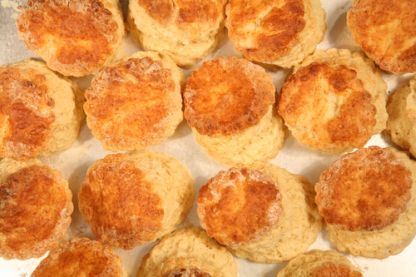Sour Cream Lemon Scones
1 lemon, orange or limes
2 cups flour
1/4 cup sugar
1 tablespoon baking powder
1/2 teaspoon salt
6 tablespoons cold butter
1 cup sour cream
1 egg white, optional
Lemon Honey Butter, optional
Preheat oven to 400 F.
Finely grate or zest lemon leaving as much white pith on the orange peel as possible (should measure about 1 tablespoon zest).
Whisk together flour, sugar, baking powder, salt and lemon zest. Add 6 tablespoons butter and coarsely cut* into flour until lumps are the size of small peas. Add sour cream and stir just until mixed (do not over mix). Flour hands, place dough on lightly floured surface and knead 4-5 times. Gently pat dough into a circle 1/2-inch thick. Cut into 8 wedges and place on baking sheet lined with parchment paper (may place on un-greased baking sheet, but bottom of scones will bake dark). Brush tops with optional beaten egg white to improve browning of tops. Bake 15-20 minutes or until light, airy and lightly browned. Serve warm with optional Lemon Honey Butter (see below).
Notes:
Popular in Scotland, scones make an airy and tender breakfast treat or delicate tea time tasty. Recipe makes 8 scones
* Quick and easy tip – grate butter into flour mixture using the large holes of a grater.
Lemon Honey Butter
Whip together 1/2 cup butter, 1/4 cup honey and zest of 1 lemon (about 1 tablespoon). Whip until butter is creamy and light. Refrigerate leftover Honey Butter.
For nutrition analysis go to www.dairycouncilutnv.org
QUICK TIPS
Popular in Scotland, Scones make an airy and tender breakfast treat. Or, my recipe makes a delicate addition to tea time (we call it supper in America).
Q. What is “Tea Time”
A. Usually a light meal served in late afternoon – and if you are a tea drinker, tea would be served. In America we would be more likely to call it Supper. It is not as heavy as a dinner nor served in courses as dinner would be.
Q. What is this term “Cut-In” Isn’t it used with pies and biscuits?
A. Yes – Cut-in is a mixing technique used when you want small bits of butter mixed in flour mixture. During baking the butter melts creating a flakey texture. Traditionally it is done with a pastry blender, 2 knives cutting in scissor action, or smashing with the tines of a fork (the fork really does smash – not truly cut-in). Here is a quick tip – grate cold butter into flour mixture using the large holes of a grater.
Q. Why are you baking the scones on parchment paper?
A. Parchment tempers the browning on the bottom of the scones. It is not necessary. I will show a comparison of baked on parchment or baked on an ungreased baking sheet.
Q. Honey Butter – hard to make?
A. Simple – whip together honey, butter and (in this case) zest from a lemon – Crowning Touch!















Add comment